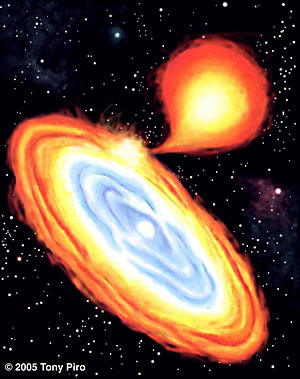A couple of years ago, a group of California theorists came up with a whacky theory for a new kind of thermonuclear supernova.
It would be just like regular type Ia supernovae, but fainter and faster, and a bit more mixed up, as evidenced by its new label: the 0.Ia supernova, a perfect mallogos of a neologism.
So now someone had to go and find one, with plenty more to come.
As you know, Bob, there are two types of Supernovae, type I and II.
Supernovae are stars blowing up, big time, and:
type I supernovae do not have hydrogen emission lines,
while type II supernovae do have hydrogen emission lines.
As it happens, type II supernovae are core-collapse supernova: the end point of core fusion for massive stars, blowing off their envelopes as their cores collapse to superdense compact neutron stars, or black holes (there may be another class of type II, the pair-instability supernova, for stars of very high mass).
In contrast, type Ia supernovae are thermonuclear detonations. The detonation fusion of the core of a star, as distinct from deflagration or quasi-static burning.
Yes, I snuck that Ia in, famously type Ib and Ic supernovae are actually subtypes of class II supernovae - core collapse supernovae which have lost their hydrogen envelopes, but I digress.
Type Ia supernovae are, mostly, "standard candles", and thus good distant calibrators, and thus of tremendous current importance; in particular the key evidence for "dark energy" comes from careful measurement of brightness of type Ia supernova as a function of their redshift (see Starts with a Bang for summary).
The other important thing to know about type Ia supernova, is that while we know, pretty much, that they are the detonation of 1.4 solar mass stellar cores, we do not know how to make such systems.
Or rather, there are several possible progenitors for systems which could lead to the detonation of a type Ia, but none appear to account, in detail for the actual observed properties of type Ias, In particular the rate of SN Ia and their rate as a function of the stellar population.
In a paper in 2007, Faint Thermonuclear Supernovae from AM Canum Venaticorum Binaries by Bildsten et al, it is conjectured that for so called AM CVn binaries, in which a low mass helium white dwarf accretes onto a more massive carbon/oxygen white dwarf, it is possible for low enough mass accretion rates, which occur as the system evolves and the stars separate, that the helium accreted builds up on the surface of the C/O white dwarf until as much as about 0.1 solar mass layer detonates.
This gives a rapidly rising, underluminous type Ia (helium emission line) supernova.
One which has peak luminosity about one tenth that of normal Ia, and rise times ten times faster.

Artist's conception of AM CVn progenitor of SN 0.Ia systems (UCB press release)
Cute.
Those whacky theorists.
'course none such had been seen, AM CVn binaries are rare, how unlikely is that.
Except, we've seen a lot of supernovae, including hundreds of type Ia supernovae, and calculations suggested an event rate of SN 0.Ia that is maybe few percent of the regular Ia rate, so even with the 0.Ia being fainter, and therefore harder to observe, there might just be some hidden in the known dataset of supernovae.
And so there is: SN 2002bj

SN 2002bj in NGC 1821
An Unusually Fast-Evolving Supernova by Poznanski et al (Science Express - (sub)
This is a fast, underluminous type Ia supernova, found in the Lick Supernova Survey, and independently by an amateur astronomers - T. Puckett and J. Newton of Puckett Observatory.
Ok, so it is a fast type Ia-like supernova, but how do we know it is one of the type predicted by Bildsten et al.
Well, they didn't just blow up helium slabs over C/O cores, they ran nuclear reaction nets in simulations of the detonation, and found anomalously large quantities of 48Cr formed - up to thousandth of a solar mass - as well as the usual nickel and iron.
And, as you know, Bob, 48-Chromium is radioactive and decays rapidly through electron capture to 48V - the 48-Vanadium is also radioactive, but with a longer half-life, so it ought to be seen during the peak light curve.
And so it is!.
Barely.
The Poznanski et al paper makes a case of seeing VII emission in between a forest of Ca/Si/Mg/S lines in the spectrum of SN2002bj, and hence support for the conclusion that this is a genuine type 0.Ia supernova, with associated anomalous isotope abundance in the ejecta due to the different temperature and pressure profiles during detonation.
Plausible.
And, since it is there, and we discover shitloads of supernova each year now, more all the time, we ought to find more of these very soon, characterised by their rapid rise
Since we now know to look for them, much better spectra can be taken, sooner, to catch the evanescent vanadium emission and confirm their nature.
This is very cool.
Theoretical predictions like that are annoyingly rare, and Bildsten and colleagues seem to have nailed this one.
